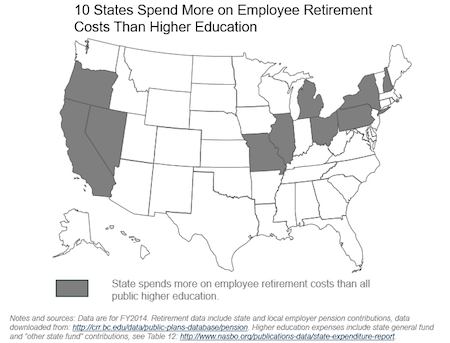Earlier this month, The New York Times ran a story called “Higher Education in Illinois Is Dying” and cited rising pension costs as a major factor in the state’s budget woes. Similarly, in our recent report on pensions in the state of Illinois, we noted Illinois taxpayers are now contributing more toward teacher pensions alone than for all of the state’s public colleges and universities combined.

Unfortunately, Illinois is not alone. Like the insatiable Pac-Man, pensions are eating further and further into state and local education budgets, eating up dollars that could be spent on lots of other things. That’s true for all public services, but higher education is uniquely harmed by rising pension costs.
To get a sense of where this is happening, I collected data on state and local contributions toward employee retirement plans from the Boston College Center for Retirement Research. To count total retirement spending, I included all state and local contributions, because some states require cities or school districts to make the majority of retirement plan contributions, while others handle it all at the state level. (Not all of the plans are traditional defined benefit pension plans, but most are. Contributions to defined benefit pensions are also more volatile than contributions to defined contribution plans, and they’re the ones driving up state and local retirement plan costs. Update: To be clear, these plans include teachers and non-teachers alike. This calculation is meant to count all state and local spending on retirement costs.) The data do not include all local plans, but they do capture most of the largest local retirement plans. If anything, this method is likely under-counting total retirement spending. Next, I collected data on each state’s total higher education spending (public and private) from the National Association of State Budget Officers. To get a sense of state spending on today’s college students, I excluded expenditures on bonds and contributions from federal funds. Both sets of data are for Fiscal Year 2014.
By comparing these two data sources, I found 10 states where retirement costs are higher than higher education spending–California, Illinois, Michigan, Missouri, New Hampshire, Nevada, New York, Ohio, Oregon, and Pennsylvania (see map below).

In general, these 10 states tend to have a few things in common. Most fall near the bottom of the list in terms of responsibly funding their pension plans. Some states on the list don’t spend that much money on their higher education systems. Several of the states have flat, aging population bases. Most are traditionally “blue” political states where voters are presumably more likely to value government spending on social services.
What to make of this finding? That depends on your perspective, but over time, I suspect higher education budgets will continue to be squeezed in favor of pensions. On the retirement side, costs will likely continue to rise. Even amidst one of the longest and strongest bull markets in history, pension plans still haven’t recovered, and if pension plans fail to hit their 8 percent investment targets every year, they will need taxpayers to continue bailing them out. Higher education will be one of the primary losers from this arrangement. That’s because higher education is unique from other public services in a few ways:
1. No state constitutional protections. Higher education typically does not have the same constitutional protections as K-12 education does. Whereas advocates can and do take to the courts for adequate state funding in the K-12 sector, there’s no such parallel in higher education.
2. The ability to raise prices. In higher education, the students themselves are asked to pay a share of their educational expenses. Over time, the share that students are asked to pay has risen as states turn to tuition increases to address budget deficits.
3. Lack of federal incentives. In other budget areas, including K-12, Medicaid, transportation, and a host of other social service programs, states lose out on matching federal dollars when they cut funding. In contrast, there’s no meaningful lower-bound for higher education, and in fact the federal government picks up much of the tab when states cut higher education funding.
To get in front of one common misconception, this situation is not merely a natural consequence of changing demographics. Unlike Social Security, where current workers pay for current retirees, defined benefit pension plans are supposed to be pre-funded. That is, pension plans were supposed to put away enough money in each successive year such that they’d be able to afford benefit payments down the road. Over time, through a combination of poor funding practices and unstable investment returns, pension plans have failed to live up to that promise.
Finally, regardless of how much meaning we attach to this comparison, it’s a prime example of how pensions are serving as an inter-generational transfer of wealth. This is true for individual teachers–states have cut benefits for new teachers so much that new teachers starting today will never get benefits worth as much as the amount of money that goes into their pension plan–and it’s true for all other citizens as well. If state and local governments are required to pour money into pension debts, that’s money they won’t have available to support other government services, including higher education. One under-appeciated consequence of this arrangement is that college students are being asked to pay higher tuition bills at least in part due to growing pension obligations.
The pension obligations are not going away anytime soon, and there’s no magic solution for paying down those past debts. But the sooner states realize that their volatile defined benefit retirement plans are harming all other areas of government, the sooner they can start looking for better models.
—Chad Aldeman
This post originally appeared on TeacherPensions.org


